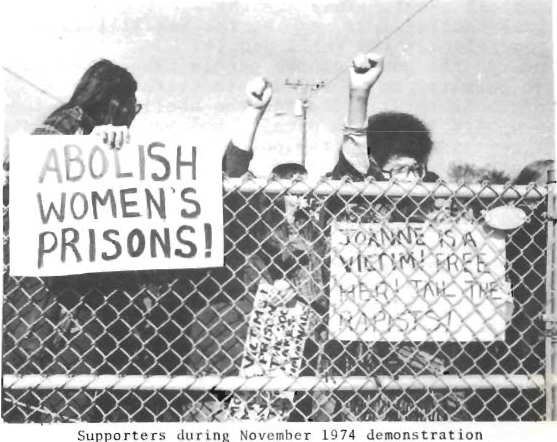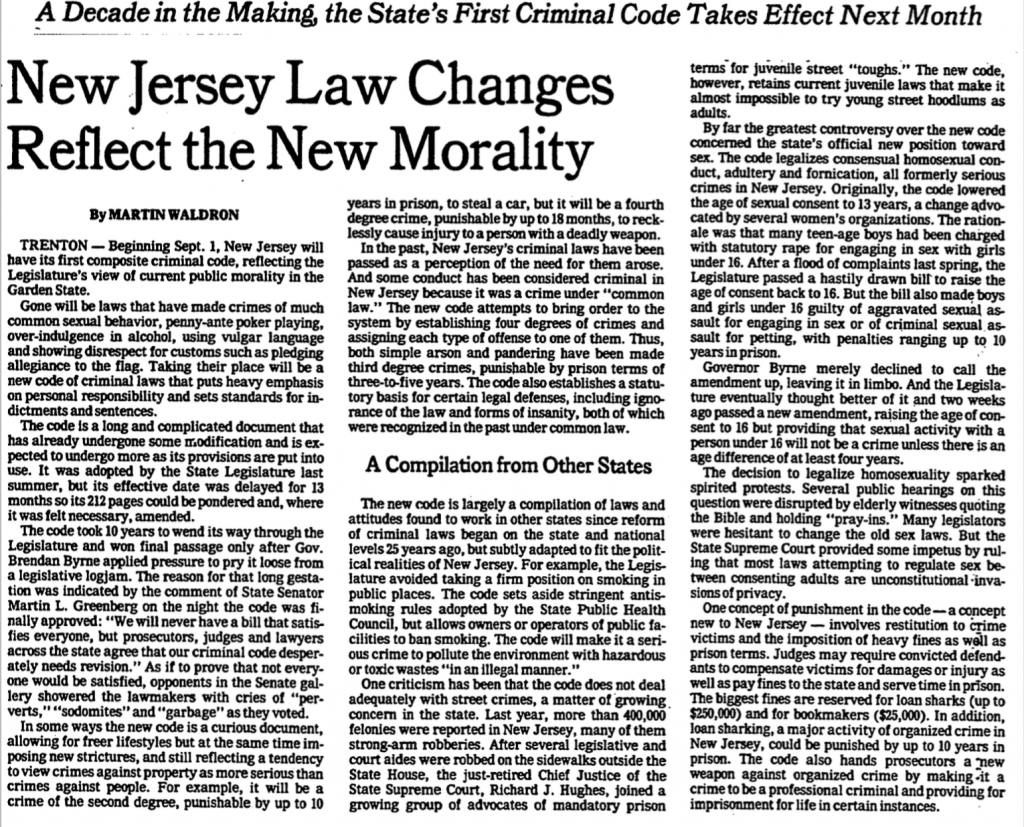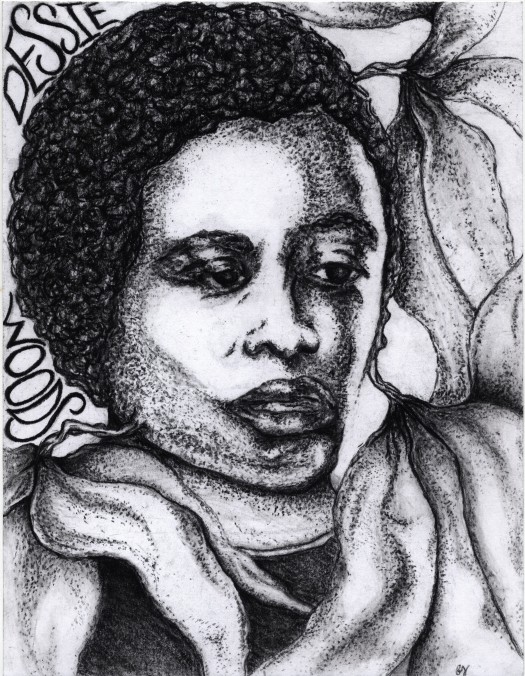Moderated by Regina Kunzel
In this final round of an ongoing conversation of histories of sexuality and the carceral state in the U.S., our contributors reflect upon the connections between their historical research and political activism against mass incarceration. Be sure to check out rounds one and two.
Regina Kunzel: I’d like to conclude our discussion by returning to Sarah’s striking observation in our discussion’s first round, that “If numbers of prisoners were the only metric of significance, the history of the emergence of the penitentiary would matter little compared to post-1970s histories of incarceration.” Though all of your projects largely precede these histories, you all conceived your research in the context of mass incarceration and the rise of critical prison studies. In what ways have the questions and issues raised by the contemporary carceral state influenced your work? How do you understand your historical research on sexuality and the carceral state in relation to the rise of mass incarceration since the 1970s?

Elias Vitulli: My project grew from a desire to historically contextualize trans and gender nonconforming people’s current experiences of carceral violence. Starting from an assumption that violence is not random or individual but systemic, I look to the past to reveal how and why the carceral state and, especially, prison and jail administrations target gender nonconformity for violence and isolation. This starting assumption emerged out of scholarship in critical prison studies, which has revealed the deep roots of the US prison system and criminal legal system in chattel slavery and colonial conquest, and argued that the racialized ideologies produced in these two interconnected systems of domination continue to structure and be reproduced by the carceral state. This scholarship, thus, reveals the centrality of white supremacy, anti-blackness, and settler colonialism to the purpose, logics, and organization of the carceral state throughout its history. Less developed within this scholarship—yet no less important—is an analysis of how sexual and gender systems of power are intimately intertwined with racialized systems of power that have fundamentally shaped the carceral state. In other words, critical prison studies has produced a framework through which to understand the current criminal legal system and carceral state as deeply interconnected with systems of domination.
Looking to the history of penal management practices regarding trans and gender nonconforming prisoners allows me to understand how new laws and policies that are ostensibly meant to protect such prisoners actually authorize and re-institutionalize targeted violence. For example, in the last two decades, some state departments of corrections and the Federal Bureau of Prisons have created official, centralized policies governing the management of trans prisoners. Initially addressing only access to gender-affirming medical treatment, such as hormone therapy and sex reassignment surgeries, more recent policies are more holistic, often addressing not only medical treatment but also housing, access to gendered clothing and hygiene products, and search procedures. These policies are the result of the interplay between: (1) the imperative produced in part by mass incarceration to “professionalize” and standardize penal management practices; (2) increased legal, medical, and social awareness of trans people; and (3) lawsuits brought by incarcerated trans people challenging the conditions of their incarceration. A cursory glance at only these policies can make them appear new, unique in the two-hundred-plus-year history of jails and prisons in the U.S. Indeed, they are often the first time that trans people have been recognized through official policy as a distinct population (although that recognition is usually framed through medical diagnosis). However, these policies build on practices and discourses produced through penal management concerns about gender nonconformity throughout the past century.
While these policies provide new resources for prisoners and their advocates, they seem to have done little to mediate the violence that incarcerated trans people experience. Indeed, they often justify isolation, denial of medical treatment, refusal to recognize someone’s gender identity and/or expression, and other forms of psychological, physical, and sexual violence. For example, while the new departments of corrections policies provide new mechanisms, or at least more explicit instructions on how to determine the safest housing option for trans prisoners—including stating that trans prisoners should be placed in a men’s or women’s institution on a case-by-case basis, not solely according to genital status—penal administrators continue to overwhelmingly house trans prisoners based on their genital status and to use segregation as a primary means of “protection.” Yet, prisoners in segregation usually experience extreme isolation, restrictions of privileges and access to programming, and greater risk of physical and sexual violence perpetrated by staff. As I discussed in my response to the previous question, the continuity of the material experience of segregation, despite the changes in explicitly stated justifications (i.e., from protecting penal institutions and gender normative prisoners from gender nonconforming prisoners to protecting gender nonconforming prisoners from other prisoners), turns violence and punishment into “protection” (at least in official rhetoric).
We should not think of this outcome as a failure of these policies, but rather a result of the limits and dangers of state recognition. These new policies remain mired in and often reproduce longstanding carceral narratives of gender nonconformity as dangerousness and security risk. These narratives are often implicit yet foundational, thus understanding the history of penal policies, practices, and narratives regarding gender nonconformity is vitally important to understanding why these policies emerged, how they are framed, and what they actually do. This analysis has important political implications. If, as I argue here, violence against incarcerated trans and gender nonconforming people is a fundamental part of the discursive and material infrastructure of the carceral state, criminal legal reform cannot end that violence. Thus, at the heart of my project—along with, arguably, critical prison studies as a field—is an urgent call for prison abolition.
Scott De Orio: Thanks to Elias for the brilliant illumination of how carceral practices and policies established earlier in the twentieth century shape the oppression of trans and gender-nonconforming people today. In my project, I am likewise invested in examining the historical construction of an aspect of the contemporary U.S. carceral state: the mass criminalization of sexual conduct involving minors. During the last four decades, a bipartisan coalition of child protection advocates has been conducting a war on child sexual abuse that has transformed pedophiles into one of the most despised and highly criminalized populations in the U.S. Ironically, the war on child sexual abuse has done a poor job of actually protecting children from sexual harm, because it simplistically blames the problem on individuals as opposed to structural factors, such as children’s economic dependence on adults and lack of access to sex education. At the same time, it has impaired the freedom of young people—even sophisticated teenagers—to say yes to sex that they do want.
While historians of the carceral state have focused mostly on race, my work reveals age to be an axis of social difference that has been central to the rise of mass incarceration. Recent scholarship in the interdisciplinary field of childhood studies has drawn attention to how age functions as a major social hierarchy and oppression alongside race, gender, sexuality, and disability. Yet few scholars of the carceral state have integrated this insight into their work. Today, between ten and twenty percent of state prisoners are incarcerated for sex offenses, and in some states the rate is as high as thirty percent. There are almost a million people on sex offender registries nationally—including, as a recent study by the sociologist Trevor Hoppe has revealed, a staggering 1% of all black American men. Since the dawn of the modern war on child sexual abuse in the 1970s, child protection advocates have deployed rhetorical hyperboles drawing binary distinctions between predatory adults and innocent children that have fueled the expansion of the branch of the carceral state concerned with controlling sex crimes.
Placing age at the center of my analysis also illuminates the unevenness of the trajectory of LGBT rights since the 1960s. Many popular and scholarly accounts have portrayed that trajectory too simply, in terms only of progress. One of the consequences of this has been that critics have missed how the welfare of LGBT teenagers, like Antjuanece Brown, has actually suffered during the same period.

One part of my project, “Punishing Queer Sexuality in the Age of LGBT Rights,” examines the rise and fall of a progressive coalition in the 1970s consisting of gay activists, feminists, intellectuals, and youth liberation activists who sought to redefine how the state regulated the sexuality of young people. Within that coalition, there was little consensus about what form the new system of regulation should take. Some gay rights activists challenged the legal scapegoating of homosexuals as child predators—a trend that was prevalent at midcentury. The type of reform that these activists sought was a “negative” right to be left alone by the state and to be free from legal discrimination. Others made the more far-reaching argument that teenagers deserved an affirmative, “positive” right to sexual freedom. In 1978–79 feminists in New Jersey, who were instrumental in revising the state penal code, had the age of consent lowered from 16 to 13 in an effort to prevent older and younger teenagers who had sex with each other from being criminalized. Their attempt was short-lived: a campaign led by conservatives against the reform defeated it before the new penal code went into effect. Still others, including the French philosopher Michel Foucault and the feminist intellectual Kate Millett, argued for the liberation, sexual and otherwise, of children of any age. The North American Man/Boy Love Association (NAMBLA), a gay activist group founded in Boston in the late 1970s, issued the most publicly visible expression of this position when it demanded that all age-of-consent laws be repealed.
In response to a government crackdown on NAMBLA and the other groups that espoused this latter view, the mainstream gay-rights and feminist organizations that had once defended the rights of teenagers stopped doing so, lest they too be accused of promoting child sexual abuse. Now unhindered by political protest, the child-protection movement transformed child sexual abuse into one of the leading issues of victims’ rights. The result was to contribute to the national rise of mass incarceration, in the process criminalizing many teenagers themselves for non-coercive sexual conduct.
Jen Manion: As Scott points out in his discussion of sex offender and age of consent laws, the 1970s were a very important period for scholars and activists on the left pushing back against and questioning the carceral state. The scholarship was incredibly robust, challenging the long-held assumption that punishment became more humane and contained in the transition from the colonial period to an independent state in the U.S. The two earliest studies – David Rothman’s Discovery of the Asylum and Michel Foucault’s Discipline and Punish are bedrock texts in history and the humanities more generally for their innovative critiques of ‘so-called’ progress. As Estelle Freedman showed in Their Sisters’ Keepers, officials were never really sure how to deal with women in prison, confirming that white men were really the true targets of reformative incarceration. Scholars examined the role of punishment in a democracy and grappled with seemingly contradictory investments in both freedom and incarceration, as in Thomas Dumm’s Democracy and Punishment and Michael Meranze’s Laboratories of Virtue. Some of the current critiques of mass incarceration and the prison industrial complex that are in circulation today are not new at all but can be found in this early work.
The big difference between older scholarship and the current body of work is the foregrounding of race. Leslie Patrick was ahead of the times with her 1989 dissertation “Ideology and Punishment: The Crime of Being Black (Pennsylvania, 1639-1804),” in which she defines racism as an ideology in punishment, linked to both liberalism and abolition. These are the concepts being interrogated right now by a new generation of scholar activists in critical prison studies. There are too many important books that have come out in the past ten years for me to list them here, but let me summarize the impact of this scholarship: the history of punishment in the U.S. demonstrates that racism is the beating heart of the American justice system.
I began researching my book in 2005, just as this new wave of critical prison studies was forming. Since most of this scholarship concerns the twentieth century, I was wary that its insights might be anachronistic for my work on the eighteenth century. Even though my primary investment in history is its value as a tool for social justice in the present, I am committed to understanding the past on its own terms as much as possible. So, I waited until I had a pretty good sense of what was going on between 1780-1830 for my book before looking at the ways it connected with the newer work. The two books that changed the conversation for me as well as the way people engaged with my project are Regina Kunzel’s Criminal Intimacy (2008) and Michelle Alexander’s The New Jim Crow (2010). Kunzel put prisons into sexuality studies and sexuality into prison culture in ways that no one had previously even conceived of let alone demonstrated. Alexander’s book inspired many young people to want to learn more about the history of American injustice. People on the left tend to think of early America as less relevant to the present or less political (which is terribly ironic given how central founding fathers and the Constitution are to the rightwing in American political thought), so I’m always trying to convince people that issues we care a great deal about now were also being debated over two hundred years ago.
You can’t really understand the hows and whys of mass incarceration without also looking through a lens of gender and sexuality. American injustice is ripe with contradictions and double standards that cut along lines of race, class, gender, and sexuality in sometimes complicated ways. While many white LGB Americans no longer view the police as a group that is fundamentally hostile towards them, young LGBT people of color and transgender people are routinely targeted and harassed. Eli’s work shows what a complicated experience prison can be for transgender people navigating an already violent gender binary system whose accommodations can be more punishing than accommodating. This is especially important now, as Scott’s work shows the significant increase in imprisonment for sex-related crimes. And as I mentioned in my last post, who was targeted for crimes related to sex and sexuality–such as sex work or sodomy–was intimately shaped by one’s race, class, and context. Sarah showed how important this was for understanding the punishment of black women for “violating codes of motherhood” rather than for “deviating from sexual rules of behavior” in our last exchange. Only by examining the carceral state through multiple and intersecting lens, will we ever be able to identify the fissures in this seemingly impenetrable wall of injustice.
Despite all of this new knowledge and all of these important mobilizations–from #blacklivesmatter to black and pink to decades-old prison abolition organizations—we should be concerned that the carceral state will be EXPANDED rather than minimized or abolished, as has so often been the case throughout its history when it is scrutinized by those who it targets.
Sarah Haley: In 1987 Hazel V. Carby argued that the “institutionalized rape of black women has never been as powerful a symbol of black oppression as the spectacle of lynching.” After reading those words as a graduate student, I was struck by their continued resonance, despite the painstaking and brilliant work of black feminist scholars across disciplines, before and since, to historicize the sexual violation of black women. Much ink has been spilled, volumes of historical documents mined, and thousands of pages of scholarly writing produced about black women’s experiences of racial/sexual violence. Yet state violence against black women does not capture the popular imagination with the same degree of intensity as narratives of police brutality against black men.
There were no book-length histories of black women and incarceration when I began my research, but it was heavily influenced by grassroots activists and the groundbreaking work of scholars largely outside of the discipline of history, including Angela Y. Davis, Beth Richie, Patricia Williams, Dorothy Roberts, and Kimberlé Crenshaw to name only a few. Soon Kali Gross’s Colored Amazons was published, demonstrating that black women’s imprisonment was an important historical subject and producing a model for examining how gender, race, class, and sexuality shape criminal punishment. Colored Amazons set the ground for future research on black women and criminal punishment.

The parallels between the historical and contemporary carceral subjugation of black women are so stark and manifold that I feel almost uncomfortable listing them, given the historian’s mandate to seek evidence of change. While the economic imperatives of mass incarceration are dramatically different in the late-twentieth and twenty-first centuries than they were in the nineteenth and early-twentieth centuries, the grisly modes of criminalization and violation involved in achieving these ends are similar. From the late-nineteenth and early-twentieth centuries, African American women were targeted and imprisoned for criminally bad motherhood or child endangerment, a trend that reemerged in the late twentieth and early twenty-first century. They were also charged with larceny, hauled into court, sentenced to exorbitant fines and time on the chain gang for economic crimes of familial survival such as stealing undergarments or linens, persecution that resembles the targeting of black women for “crimes” of basic subsistence, as in the 1984 murder of Eleanor Bumpurs, to name just one case.
Black girls were seen as disproportionately disorderly (in Atlanta in 1893 black male youth were three times more likely to be arrested than young white males, while black girls were nineteen times more likely to be arrested than their white female counterparts), a trend that scholars such as Kimberlé Crenshaw, Priscilla Ocen, Jyoti Nanda, and Monique Morris have analyzed in contemporary context. Black women were disproportionately prosecuted and imprisoned for drug crimes (then possessing or distributing whisky), as is the case today. In nineteenth-century Georgia, rape was an institutionalized feature of imprisonment and women were forced to give birth to children conceived as the result of rape by prison guards; guard rape remains prevalent in Georgia’s state prisons.
In 1909, Lula Walker wrote a letter to the Georgia Prison Board explaining that her niece, Emma Johnson, was just one example of “how often the unfortunate Negro Women may suffer at the hands of a jury.” Walker argued that her niece should never have been convicted for killing her husband because he was abusive and, she argued, “Ga. law plainly says when your life is threatened and you are assaulted with anything the sise of an ordinary marble you may make the fatal blow and it will be Justified Homicide.” Despite this letter outlining the circumstances, Emma’s parole request was denied. As Johnson’s case reveals, black women who survived being raped or assaulted by intimate partners were punished for defending themselves. In those cases in which details of the criminal acts are known, at least forty percent of women imprisoned for murder or attempted murder in late-nineteenth-century Georgia were acting in self defense against gendered violence. The criminalization of black women for defending themselves continued into the twentieth century, exemplified in the cases of Rosa Lee Ingram and Dessie Woods. Yet, criminalizing women of color for self defense remains a reality in the lives of women and girls, as evidenced by numerous cases including most recently that of 14-year-old Bresha Meadows.
Between 1977 and 2004, women’s incarceration had risen by 757%, with an unprecedented 96,125 women imprisoned in the United States; black women comprised fifty percent of the female prison population. The exact figure—whether women’s incarceration had risen by 200% or 388% (the rate of increase for men) or 700%—seemed less important than the fact that the intersections of gender and race and class were clearly shaping mass incarceration, and devastating many lives in the process. Carceral violence is, as Elias argued, systemic. Gendered and sexual carceral violence and prosecution continue to strengthen racial constructions of citizenship, protected human life, and “normal” families. Gendered regimes of punishment still delineate the limits of state economic liability and obligation. These continuities reflect the urgency of historical scholarship that examines modes of resistance, refusal, and collective organizing against carceral sexual and gendered violence. Careful attention to these ideas, acts, movements, and cultures is urgent, especially in light of Jen’s critical point that expansive critiques have historically been coopted for carceral reform and expansion rather than the necessary goal of abolition.
 Regina Kunzel is the Doris Stevens Chair and Professor of History and Gender & Sexuality Studies at Princeton University. Her most recent book is Criminal Intimacy: Prison and the Uneven History of Modern American Sexuality (University of Chicago Press, 2008). She is currently working on a book exploring the encounter of sexual- and gender-variant people with psychiatry and psychoanalysis in the mid-twentieth-century U.S.
Regina Kunzel is the Doris Stevens Chair and Professor of History and Gender & Sexuality Studies at Princeton University. Her most recent book is Criminal Intimacy: Prison and the Uneven History of Modern American Sexuality (University of Chicago Press, 2008). She is currently working on a book exploring the encounter of sexual- and gender-variant people with psychiatry and psychoanalysis in the mid-twentieth-century U.S.
 Sarah Haley is Assistant Professor of Gender Studies and African American Studies at the University of California, Los Angeles. Her research focuses on black feminist analyses of the U.S. carceral state from the late-nineteenth century to the present, black women and labor, and black radical traditions and organizing. She received her PhD in African American Studies and American Studies. Her first book, No Mercy Here: Gender, Punishment, and the Making of Jim Crow Modernity (UNC Press, 2016), examines the lives of imprisoned women in the U.S. South from the 1870s to the 1930s and the role of carcerality in shaping cultural logics of race and gender under Jim Crow. She has also worked as a paralegal for the New York Office of the Federal Public Defender and as a labor organizer with UNITE-HERE. She tweets from @sahaley.
Sarah Haley is Assistant Professor of Gender Studies and African American Studies at the University of California, Los Angeles. Her research focuses on black feminist analyses of the U.S. carceral state from the late-nineteenth century to the present, black women and labor, and black radical traditions and organizing. She received her PhD in African American Studies and American Studies. Her first book, No Mercy Here: Gender, Punishment, and the Making of Jim Crow Modernity (UNC Press, 2016), examines the lives of imprisoned women in the U.S. South from the 1870s to the 1930s and the role of carcerality in shaping cultural logics of race and gender under Jim Crow. She has also worked as a paralegal for the New York Office of the Federal Public Defender and as a labor organizer with UNITE-HERE. She tweets from @sahaley.
 Elias Vitulli is a Visiting Lecturer of Gender Studies at Mount Holyoke College. His research explores the connections between queer/transgender studies and critical prison studies. His current project, “Carceral Normativites: Sex, Security, and the Penal Management of Gender Nonconformity,” explores the history of the incarceration of gender nonconforming and transgender people in the U.S. from the early twentieth century to the present, focusing on the evolution and logics of penal policies and practices. He received his PhD in American Studies, with a minor in Feminist and Critical Sexuality Studies, from the University of Minnesota in 2014. His work has appeared in GLQ, Social Justice, and Sexuality Research and Social Policy.
Elias Vitulli is a Visiting Lecturer of Gender Studies at Mount Holyoke College. His research explores the connections between queer/transgender studies and critical prison studies. His current project, “Carceral Normativites: Sex, Security, and the Penal Management of Gender Nonconformity,” explores the history of the incarceration of gender nonconforming and transgender people in the U.S. from the early twentieth century to the present, focusing on the evolution and logics of penal policies and practices. He received his PhD in American Studies, with a minor in Feminist and Critical Sexuality Studies, from the University of Minnesota in 2014. His work has appeared in GLQ, Social Justice, and Sexuality Research and Social Policy.
Jen Manion is Associate Professor of History at Amherst College. Manion is author of Liberty’s Prisoners: Carceral Culture in Early America (University of Pennsylvania Press, 2015) and co-editor of Taking Back the Academy: History of Activism, History as Activism (Routledge, 2004). Jen has also published essays in Signs: Journal of Women in Culture and Society, Journal of the Early Republic, TSQ: Transgender Studies Quarterly, and Radical History Review. Manion was awarded a National Endowment for the Humanities Fellowship at the American Antiquarian Society in 2012-2013 to research a new project, “Born in the Wrong Time: Transgender Archives & The History of Possibility, 1770-1870.” Manion tweets from @activisthistory and posts articles about contemporary mass incarceration at Liberty’s Prisoners on tumblr.
 Scott De Orio is a doctoral candidate in History and Women’s Studies at the University of Michigan in Ann Arbor. His research focuses on the history of sexuality in the twentieth-century United States with a particular interest in the law and state power. His current project examines the creation of a new system of social control over queer sexual conduct in the late twentieth century. De Orio has two articles forthcoming, one in the Journal of the History of Sexuality, the other in an edited collection, The War on Sex (Duke, 2017).
Scott De Orio is a doctoral candidate in History and Women’s Studies at the University of Michigan in Ann Arbor. His research focuses on the history of sexuality in the twentieth-century United States with a particular interest in the law and state power. His current project examines the creation of a new system of social control over queer sexual conduct in the late twentieth century. De Orio has two articles forthcoming, one in the Journal of the History of Sexuality, the other in an edited collection, The War on Sex (Duke, 2017).

NOTCHES: (re)marks on the history of sexuality is licensed under a Creative Commons Attribution-NonCommercial-NoDerivatives 4.0 International License.
Based on a work at www.notchesblog.com.
For permission to publish any NOTCHES post in whole or in part please contact the editors at NotchesBlog@gmail.com





